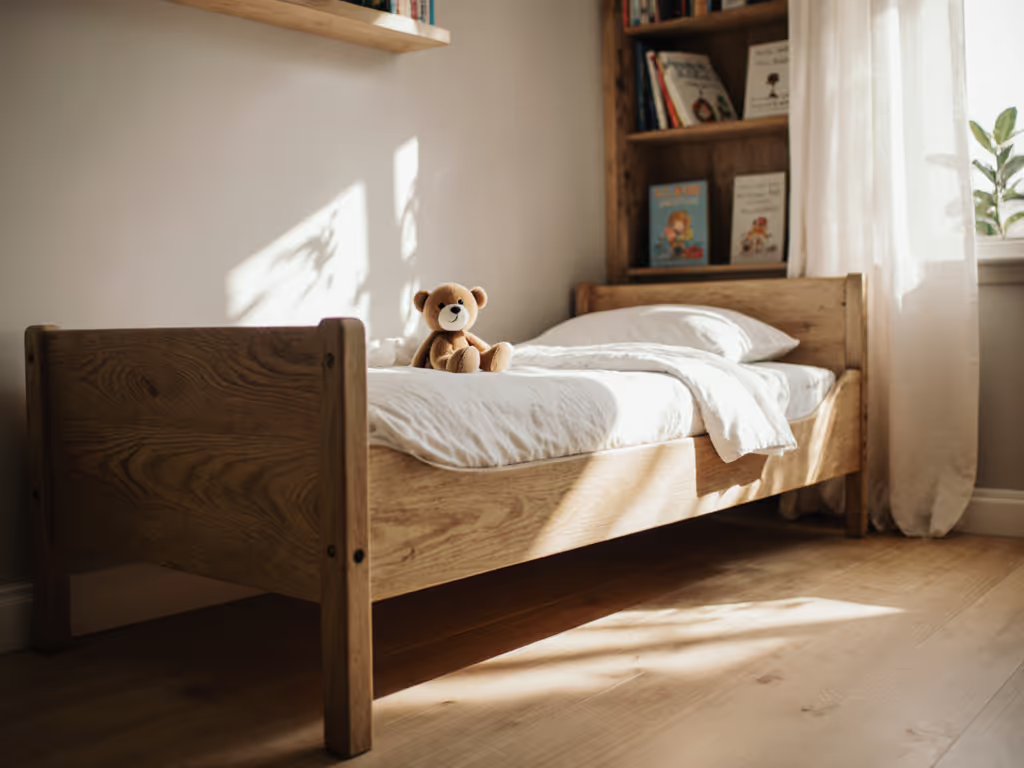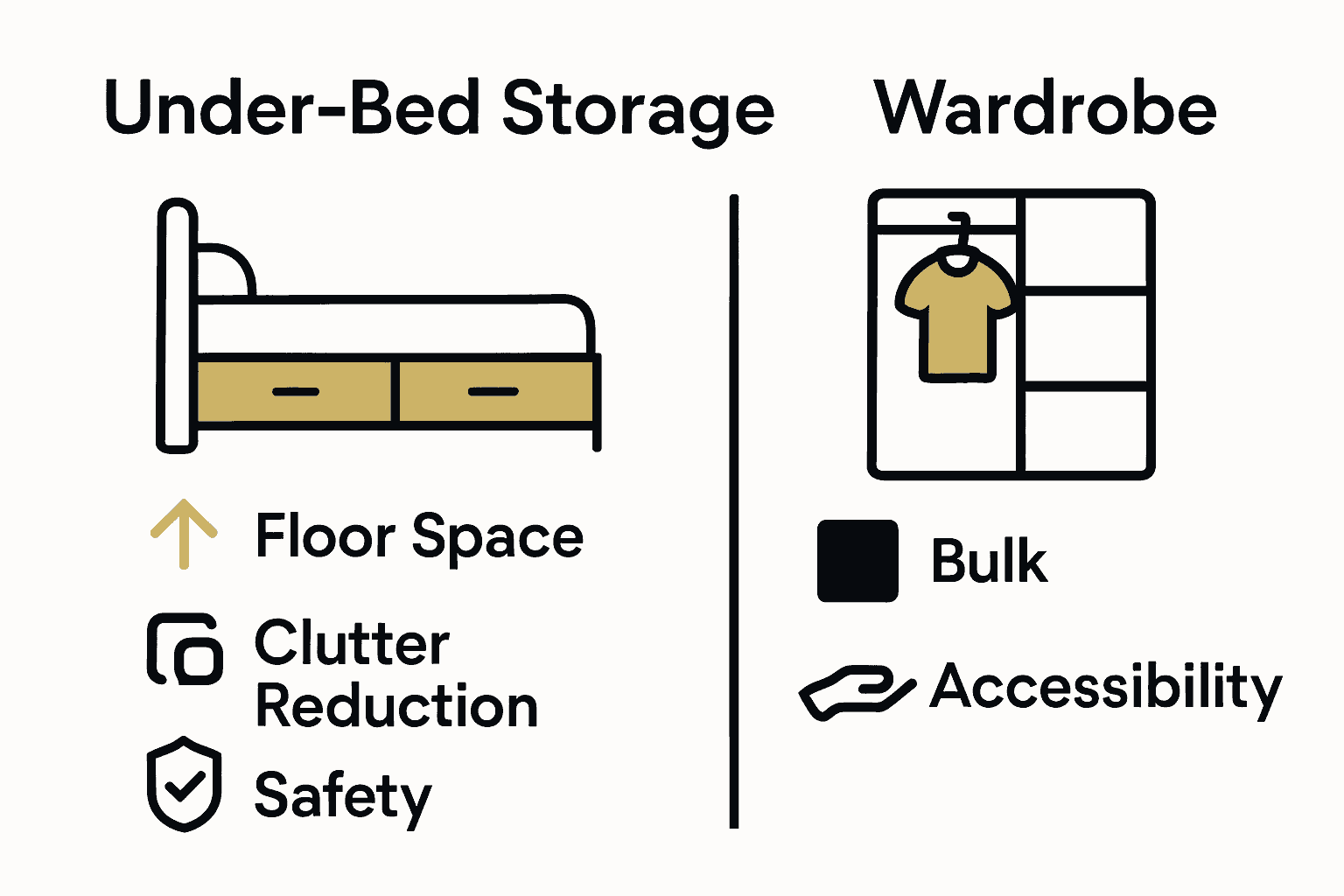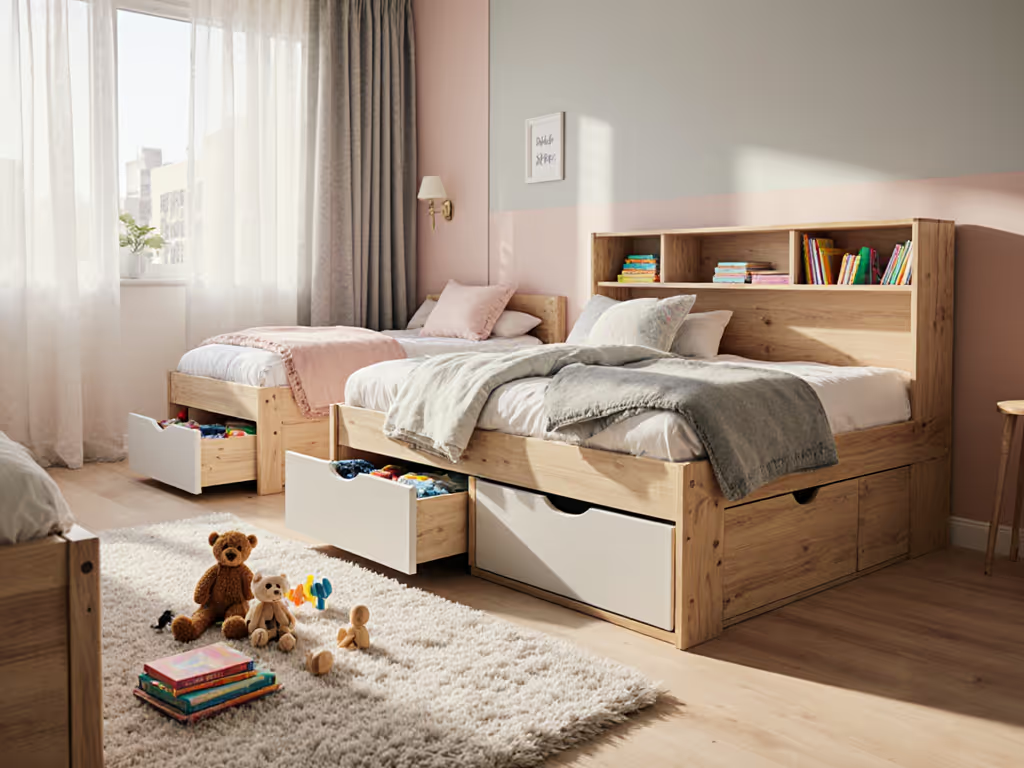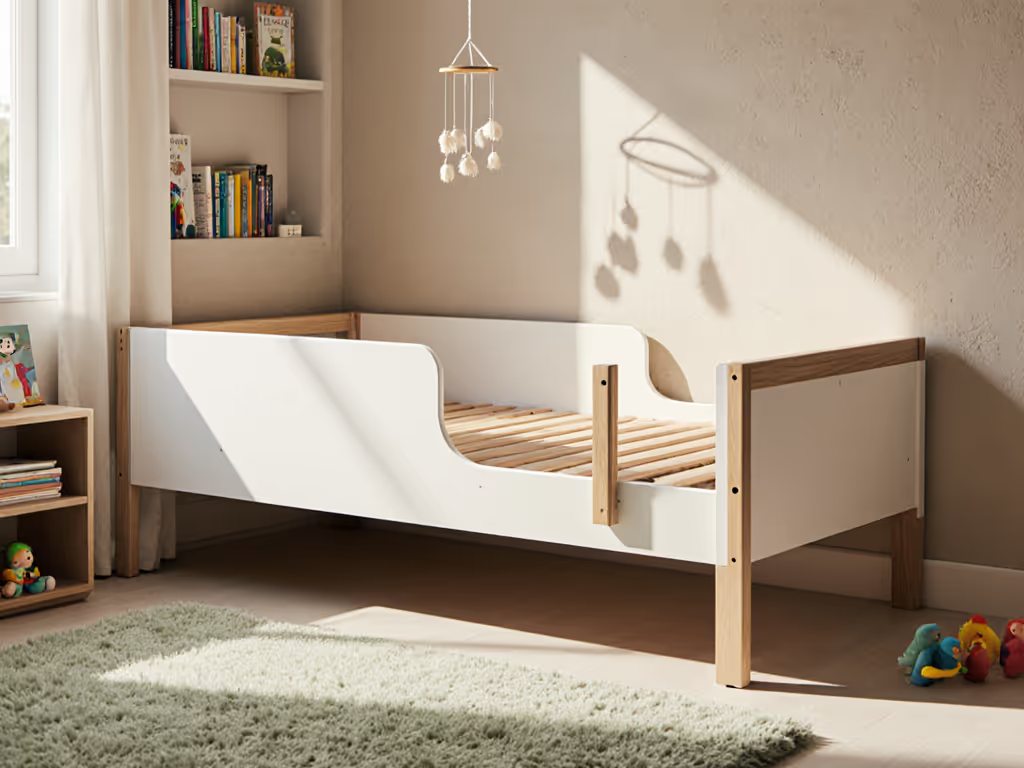
Under-Bed Storage Explained: Smart Solutions for Parents

Over 70 percent of parents in small living spaces struggle to keep children's rooms organized without adding bulky furniture. The area beneath a toddler’s bed often sits unused, yet it holds serious potential for clever storage and reducing clutter. By transforming this hidden space, families can create a safer, more functional room that actually grows with their child’s needs. If you want a simple way to maximize every inch of your child’s bedroom, under-bed storage offers a smart path forward.
Key Takeaways
| Point | Details |
|---|---|
| Maximizes Space | Under-bed storage utilizes previously wasted space, transforming it into functional organizational areas, ideal for small rooms. |
| Safety First | Designs should prioritize child safety with features like rounded edges and soft-close mechanisms to prevent injuries. |
| Accessibility Matters | Choose storage solutions that align with your child's age and capabilities to promote independence while maintaining organization. |
| Versatile Options | Various under-bed storage configurations exist, including drawer systems and modular solutions, allowing tailored organization to different needs. |
What Is Under-Bed Storage? Core Concepts
Under-bed storage transforms the often overlooked space beneath your child's bed into a strategic organizational powerhouse. Multifunctional furniture like under-bed storage systems turn unused areas into smart, efficient spaces for keeping toys, clothes, bedding, and other essential items neatly tucked away. Think of it as creating a hidden organizational zone right under your toddler's sleeping area.
At its core, under-bed storage represents a creative solution for maximizing limited living spaces. Unlike traditional storage methods that require additional floor space or separate furniture pieces, these systems integrate seamlessly into your child's bedroom setup. Parents with small apartments, shared rooms, or compact living environments can particularly benefit from this approach, which allows for efficient utilization of every square inch available.
Key Features of Under-Bed Storage
- Maximizes unused bedroom space
- Creates hidden organizational zones
- Reduces visual clutter in children's rooms
- Provides easy access to stored items
- Supports room design flexibility
The concept extends beyond simple drawers or containers. Modern under-bed storage solutions range from built-in compartments and sliding trays to specialized organizational systems designed specifically for children's bedrooms. Some advanced designs even incorporate safety features like soft-close mechanisms and rounded edges to prevent pinched fingers, making them an ideal choice for parents prioritizing both functionality and child safety.
Whether you're dealing with limited square footage or simply want a more streamlined bedroom environment, under-bed storage offers a practical approach to keeping your child's space organized. By transforming dead space into a purposeful storage area, you create a more efficient and visually appealing room that grows with your child's changing needs.
Types of Under-Bed Storage Solutions
When it comes to maximizing bedroom space for your toddler, storage solutions come in several versatile configurations designed to meet different organizational needs and room layouts. Understanding these options helps parents select the most appropriate system for their specific living environment and storage requirements.
Drawer-Based Storage Systems
Drawer-based under-bed storage represents one of the most popular and integrated approaches. These systems are typically built directly into the bed frame, offering seamless design and maximum efficiency. Parents can choose between:
- Full-extension drawers that slide out completely
- Partial drawers with limited but strategic access
- Soft-close mechanisms to prevent finger pinching
- Wooden or composite material construction
- Options with child-safe rounded edges
Rolling storage containers offer another flexible alternative for parents seeking adaptable solutions. These units can be easily moved, allowing for quick reorganization and convenient access to stored items. Typically constructed from durable plastic or lightweight wood, rolling containers come in various sizes and depths to accommodate different storage needs.
Specialized Storage Options
Beyond traditional drawers, specialized storage solutions provide unique organizational strategies. Vacuum-sealed bags emerge as an excellent option for compressing seasonal clothing, extra bedding, or infrequently used items. These bags dramatically reduce volume, creating additional space beneath the bed. Some innovative designs even include clear panels, allowing parents to quickly identify contents without opening multiple containers.
For families with specific organizational challenges, modular storage systems offer unprecedented flexibility. These adaptable solutions can be customized with removable dividers, stackable compartments, and adjustable configurations. Such systems grow alongside your child, transforming from toy storage in early years to academic supply organization as they enter school age.

When selecting an under-bed storage solution, consider factors like room size, available clearance, your child's accessibility needs, and the types of items you plan to store. The right system will not just organize space but also contribute to a clean, calm bedroom environment that supports your child's developmental stages.
Benefits and Drawbacks in Small Children's Rooms
Navigating the world of under-bed storage in small children's rooms requires a strategic approach that balances organization with safety and functionality. Parents must carefully weigh the potential advantages against possible limitations to create an optimal living space for their young ones.
Space Optimization Benefits
The primary advantage of under-bed storage lies in its ability to transform wasted space into a functional organizational system. In compact bedrooms, every square inch matters. These storage solutions allow parents to:
- Maximize limited floor space
- Reduce visual clutter
- Create dedicated zones for toys and clothing
- Keep essential items within easy reach
- Maintain a clean, organized bedroom environment
However, the benefits come with nuanced considerations. Young children may struggle with complex storage systems, potentially leading to partially organized or messy spaces. The key is selecting age-appropriate storage solutions that balance accessibility with tidiness.
Safety and Accessibility Challenges
Safety emerges as a critical concern when implementing under-bed storage in children's rooms. Potential hazards include pinch points, sharp edges, and the risk of children climbing into or becoming trapped within storage compartments. Parents must prioritize designs with:
- Rounded edges
- Soft-close mechanisms
- Child-proof locks
- Low-profile configurations
- Smooth sliding mechanisms
Accessibility presents another significant challenge. Younger children might find it difficult to independently manage under-bed storage, requiring parent assistance for retrieving or storing items. This limitation can potentially undermine the storage system's primary goal of promoting independence and organization.
Ultimately, successful under-bed storage in small children's rooms requires a thoughtful, adaptive approach. By carefully selecting systems that match your child's age, developmental stage, and specific room constraints, you can create a storage solution that grows with your family. The goal is not just organization, but creating a safe, functional space that supports your child's daily activities and developmental needs.
Safety Considerations for Toddler Environments
Creating a safe storage environment in a toddler's bedroom requires meticulous attention to design, materials, and potential interaction risks. Parents must approach under-bed storage as more than just an organizational solution, viewing it instead as a critical component of child safety infrastructure.
Physical Design Safety
The physical construction of under-bed storage systems demands careful scrutiny. Critical safety elements include:
- Rounded, smooth edges to prevent cuts or abrasions
- Absence of small, detachable components
- Secure attachment mechanisms preventing tipping
- Materials resistant to splintering or cracking
- Weight-balanced designs that maintain stability
Toddlers are naturally curious and physically unpredictable, transforming seemingly innocuous storage solutions into potential hazard zones. Soft-close mechanisms become essential, preventing sudden movements that could pinch delicate fingers. Materials matter immensely - non-toxic, lead-free compositions reduce chemical exposure risks while supporting durability.
Interaction and Accessibility Considerations
Child-proofing under-bed storage extends beyond physical design. Parents must anticipate how curious toddlers might interact with these spaces. Potential risks include children attempting to climb inside storage units, becoming trapped, or accessing potentially dangerous items. Recommended safety strategies involve:
- Installing child-proof locks
- Using low-profile storage designs
- Placing age-inappropriate items out of reach
- Implementing clear organizational boundaries
- Regularly monitoring storage contents
Beyond immediate physical safety, thoughtful storage design supports developmental independence. By creating accessible, structured storage spaces, parents can teach organizational skills while maintaining a secure environment. The ultimate goal transcends mere safety - it's about nurturing a space that grows with your child's evolving needs and capabilities.
Comparing Under-Bed Storage with Alternatives
When it comes to organizing a toddler's bedroom, parents face a complex landscape of storage solutions, each with unique advantages and limitations. Under-bed storage represents just one approach in a broader spectrum of organizational strategies, each designed to address different spatial and functional challenges.
Space Utilization Comparisons
Unlike traditional storage methods, under-bed solutions uniquely transform previously unused space into functional organizational zones. Compared to alternative options, these storage systems offer distinct advantages:
- Maximize floor space efficiency
- Create hidden storage zones
- Maintain visual room simplicity
- Reduce clutter without additional furniture
- Integrate seamlessly with existing bedroom design
Traditional alternatives like freestanding shelves or wardrobes consume valuable floor space and can make small rooms feel cramped. Over-the-door organizers, while convenient, often feel cluttered and interrupt room aesthetics. In contrast, under-bed storage maintains a clean, streamlined appearance while providing substantial organizational capacity.

Accessibility and Functional Trade-offs
Storage accessibility emerges as a critical consideration when comparing different organizational approaches. Under-bed solutions require more physical effort to retrieve items compared to open shelving or standing cabinets. This limitation can be particularly challenging for younger children or parents managing multiple tasks simultaneously.
Alternative storage methods each present unique trade-offs:
- Closet shelving: Maximum visibility, less space-efficient
- Freestanding cabinets: Easy access, larger footprint
- Wall-mounted systems: Vertical space utilization, potential mounting challenges
- Under-bed storage: Compact, discreet, but less immediately accessible
Ultimately, the ideal storage solution depends on individual room configurations, family needs, and children's developmental stages. Smart parents recognize that no single approach works universally - the most effective strategy often involves combining multiple storage techniques to create a comprehensive, adaptable organizational system.
Make the Most of Your Toddler's Bedroom with Smart Under-Bed Storage
Struggling to organize your child's small bedroom while keeping it safe and clutter-free? The article on under-bed storage highlights common challenges parents face such as limited space, safety concerns like pinch points, and the need for accessible yet hidden storage options. If you want to create a calm, functional room that evolves with your toddler's needs, understanding concepts like multifunctional furniture and child-proof design is essential.
At City Toddler Beds, we specialize in helping first-time parents navigate these exact dilemmas with expert guides and thorough advice on selecting beds that optimize space and safety. Discover how the right toddler bed can partner perfectly with under-bed storage solutions to reduce clutter, improve accessibility, and foster a more organized environment. Ready to transform your toddler's bedroom into a secure and efficient space? Visit City Toddler Beds now to explore insights and practical tips so you can take action today.
Frequently Asked Questions
What is under-bed storage and how does it work?
Under-bed storage utilizes the space beneath the bed to create organized storage areas for toys, clothing, and other items. It often includes multifunctional furniture like built-in drawers or rolling containers, maximizing unused space in a child's room.
What types of under-bed storage solutions are available for children's rooms?
Under-bed storage solutions include drawer-based systems, rolling containers, vacuum-sealed bags, and modular storage options, which can be customized with compartments and dividers. Each type caters to different organizational needs and room layouts.
What are the safety considerations for under-bed storage in toddler environments?
When using under-bed storage in toddler rooms, prioritize designs with rounded edges, soft-close mechanisms, and stable, low-profile configurations to prevent injuries. Additionally, use child-proof locks and keep hazardous items out of reach.
How does under-bed storage compare to traditional storage options?
Under-bed storage maximizes floor space and creates hidden organizational zones, making it an efficient choice for smaller rooms. Unlike shelving or freestanding furniture, under-bed systems keep items out of sight while reducing visual clutter.




